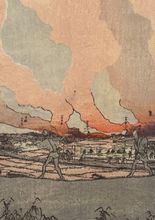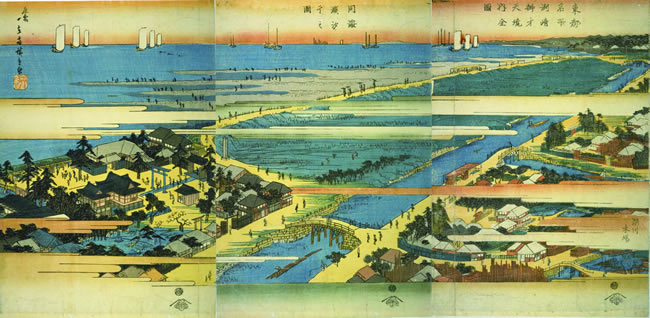Digest of public lecture “Premodern Edo was a city of disasters! A look at serial and multiple disasters”

In the winter of 2020–21, Tokyo experienced fewer days of turbulent weather compared with many regions that suffered from heavy snow. However, many readers may not be aware that Tokyo (Edo) was a city afflicted with many disasters during the Edo period (1603-1867). According to Professor Koichi Watanabe of the National Institute of Japanese Literature, who specializes in the history of disasters, there were around two fires per year and flood damage approximately every 3 years, and frequent pandemics. How did the Edo Shogunate (Bakufu) deal with bouts of such recurring catastrophes? In his talk titled “Premodern Edo was a city of disasters! A look at serial and multiple disasters”, Professor Watanabe unraveled a variety of anti-disaster measures taken by the Bakufu and analyzed these differences against backdrop of the scale of disasters and the city’s situation at that time. The online public lecture was hosted by Otemachi Academia and the National Institutes of the Humanities on Wednesday, December 16, 2020.
Professor Watanabe considers the 1780s in the Tenmei period and the 1850s in the Ansei period as times when serial and multiple disasters occurred in the city of Edo. During the Tenmei serial and multiple disasters, Edo faced many disasters over less than a decade, starting with the eruption of Mount Asama in 1783, followed by a pandemic, large fires, floods, and a storm surge in 1791. Meanwhile, during the Ansei serial and multiple disasters, Edo experienced a flurry of misfortunes between 1854 to 1858: three large fires, a typhoon, an earthquake, and a cholera epidemic. Professor Watanabe points out that there was a big difference in the Bakufu’s approaches to handling these events between the two periods. While the actions taken in response to the Tenmei disasters were direct, tyrannical measures that ignored public opinion, those in the Ansei disasters were limited to following protocols that were already in place, consequently falling short of implementing new measures, though new measures were discussed.

A drawing depicting Edo after the Ansei Great Earthquake of 1855. It shows the fires that occurred after the earthquake and views the city of Edo from Honjo Tenjingawa Bank (near Yokokawa 3-chome in Koto-ku). To the right is the Ueno area, and to the left is Fukagawa. (From “Ansei Kenmonshi,” [A Reportage of the Ansei Great Earthquake] the National Archives of Japan Digital Archive)
For example, as a countermeasure to the Tenmei serial and multiple disasters, the Bakufu established machikai-sho, an institution where rice and money are stocked in times of normalcy, and distributed to the victims as part of relief measures during disasters to prevent famine. The Bakufu also simplified the processes involved in using the stocked goods which in turn could help more victims more rapidly. In addition, the Bakufu took proactive steps to suppress the impact of flooding by removing reclaimed lands on the Sumida River and moving seaside streets. There were voices of opposition when moving Fukagawa Suzaki along the sea, but the Bakufu ignored them. These were all part of the overall Bakufu efforts, which would later be known as the Kansei Reforms. In contrast, during the Ansei period, there were talks to set up sanbutsu-kaisho, where goods from across the country would be delivered and sold in Edo. However, the idea was only discussed and was never put into action. Moreover, the Bakufu made attempts to have merchants purchase land it owned in city centers so that it could secure budget for running a military training facility. However, the purchases did not even reach one third of the goal, and it ended up as a failure.

The verdant marshland in the center is the area that was flooded by the tidal waves in 1791 (the third year of the Kansei period). The Bakufu forbid people from residing in this area as a measure against tidal waves. (From Hiroshige Ando’s “Suzaki benzaiten keidai zenzu” in “Edo Meisho Hyakkei”[One Hundred Famous Views of Edo], the National Diet Library Digital Collections.)
In these ways, the Bakufu’s policy on serial and multiple disasters differed by period. Professor Watanabe thinks that this difference can be partly attributed to the start of trading with foreign countries during the Ansei period, which occurred in tandem and necessitated military reforms. As a result, military needs were prioritized over disaster prevention.
There were around 300 registrations for the public lecture, for which there were only 100 online spots, reflecting the high interest in the talk. Participants ranged from families with children to those who had extensive knowledge about Japanese history. Together with Professor Watanabe, participants reflected on the serial and multiple disasters that occurred in Edo during the Edo Period, as well as the Bakufu’s prevention measures. The lecture and the Q&A session are available on the National Institutes for the Humanities’ YouTube channel.
(Text: Ayumi Koso)
Video of the online lecture, “Premodern Edo was a city of disasters! A look at serial and multiple disasters” is available on the National Institutes for the Humanities’ YouTube channel. This online event was organized by Otemachi Academia and the National Institutes for the Humanities.
